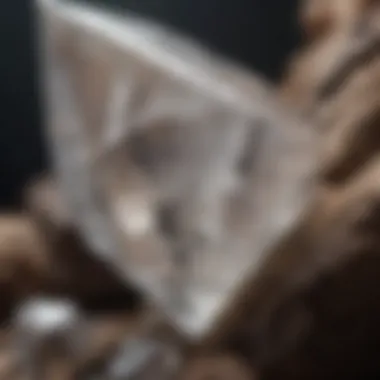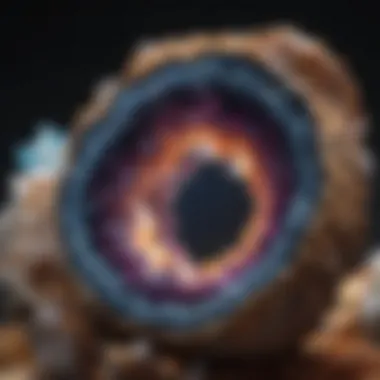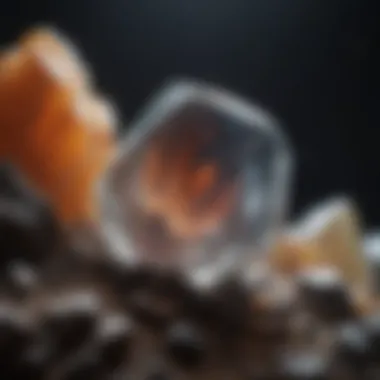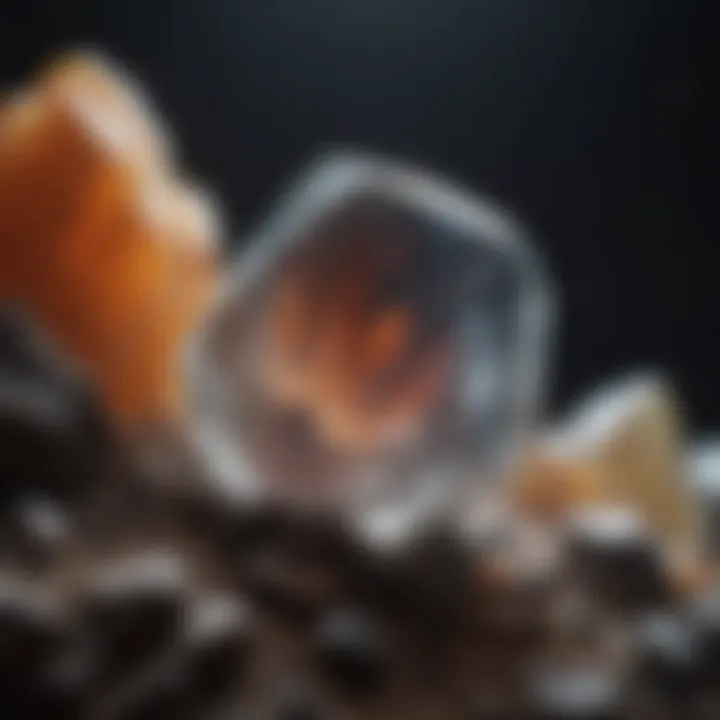A Guide to Geo Stones and Crystals: Formation and Uses


History and Origins
Earth is home to a vast array of geo stones and crystals, each telling a story etched over millions of years. Understanding their history and origins enriches the experience for collectors and enthusiasts alike. These natural wonders are not only aesthetically pleasing but are also imbued with significance that spans cultures and eras.
Overview of Collectibles, Rocks, and Fossils
From the moment humankind first gazed upon the dazzling colors and varied formations of minerals, the attraction was undeniable. Rocks and fossils, objects molded by nature itself, have been collected for millennia. Ancient civilizations, such as the Egyptians and Greeks, valued certain stones for their beauty and believed in their mystical properties.
In contemporary times, the allure of geo stones and crystals persists. Collectibles can range from polished gemstones to raw mineral specimens. Their intrinsic value can be determined not only by rarity but also by their geographic origin and perceived metaphysical properties. Each type or specimen has a unique story, often tied to a specific culture or historical event.
Historical Significance and Cultural Impact
Throughout history, geo stones have played pivotal roles in various cultures. Jade, revered in Chinese culture, is associated with purity and moral integrity. The ancient Egyptians crafted ornate jewelry and burial masks from turquoise and lapis lazuli, believing these stones would safeguard the deceased in the afterlife. Meanwhile, the indigenous people of North America utilized quartz for tools and rituals, recognizing its significance in their traditions.
The fascination with geo stones continues to evolve. The rise of New Age spiritual practices has brought attention to the healing properties attributed to certain crystals, influencing both collectors and those seeking alternative therapies. The blending of ancient beliefs with modern practices creates a rich tapestry of cultural interpretations that continue to shape the understanding of these natural artifacts.
Identification and Classification
To navigate the world of geo stones and crystals, one must become familiar with their identification and classification. With thousands of minerals and stones out there, proper knowledge is crucial for enthusiasts and collectors alike.
Guide to Identifying Rocks and Fossils
Identifying geo stones involves examining various characteristics. Collectors often look for the following:
- Color: The hue may indicate specific mineral content.
- Hardness: Using the Mohs scale helps determine a stone's durability.
- Luster: The way light interacts with a stone’s surface can clue an observer into its identity.
- Texture: Some stones may feel smooth, while others are rough or crystalline.
For fossils, clues often come from examining the imprint or structure, which can provide essential information about the organism and its environment.
Common Types and Variations
The world of geo stones and crystals includes many common types. Familiarizing with a few can vastly enhance appreciation:
- Amethyst: A purple variety of quartz; said to aid in calmness.
- Rose Quartz: Often called the love stone, associated with emotional healing.
- Obsidian: A volcanic glass, prized for its sharp edges and historical use in tools.
- Fossilized Wood: This transformation process preserves the structure and creates a stunning decorative item.
Each category contains numerous variations, showcasing the diversity birthed by geological processes across climates and the ages.
"Every stone tells a story, but it takes a careful eye and curious mind to listen."
Prolusion to Geo Stones and Crystals
Geo stones and crystals hold a significant piece in the rich tapestry of the Earth's natural history. Understanding these geological treasures not only appeals to the aesthetic senses but also opens a window to the intricate processes that have formed our planet over millions of years. By studying these specimens, one can glean insights into Earth's evolution, the dynamic forces at play, and the conditions that foster the development of each unique stone and crystal.
Among rock and fossil collectors, the allure of geo stones is multifaceted. First, these stones represent the raw materials of the Earth, showcasing the beauty and diversity of geological processes. Furthermore, they present a possibility for scientific inquiry and the exploration of Earth’s complex history, thus solidifying a connection to ancient natural events. This connection provides a bridge from mere collection to a deeper appreciation of geology as a field of study.
In addition to their natural beauty and scientific value, many collectors and enthusiasts find personal significance in their collection of geo stones and crystals. Each piece tells a story, whether it be something rooted in cultural significance, therapeutic uses, or simply the joy of unearthing a natural masterpiece. It's common to hear collectors say that their stones act as a source of inspiration, reminding them of the Earth's wonders and their own journey.
When it comes to discussions around geo stones, one must also address the ethical considerations that accompany their collection. Responsible sourcing is essential for preserving both the Earth’s resources and the integrity of the geological community. Collectors and enthusiasts should be acutely aware of the implications of their choices, considering not only what benefits they may derive from their collections but also how those choices impact the environment.
"Every rock tells a story, but only if you take the time to listen."
Geological Formation
Understanding geological formation is pivotal when exploring geo stones and crystals as it lays the foundation for their origin and characteristics. The process by which minerals form not only influences their physical properties but also provides insight into the environmental conditions of Earth’s history. For collectors and enthusiasts alike, knowing how these stones come to be enriches their value and significance. It also fosters a deeper appreciation for the natural processes that have shaped our planet over millions of years.
The Process of Mineral Formation
Mineral formation can be broadly categorized into three main types: igneous, metamorphic, and sedimentary. Each of these categories encapsulates unique processes and characteristics that contribute to the variety of geo stones available today.
Igneous
Igneous rocks are formed from the solidification of molten magma, either beneath the Earth's surface or after it erupts from a volcano. One of the most celebrated aspects of igneous rocks is their diversity, ranging from granite to basalt. This formation process is what gives igneous stones their robust nature.
A key characteristic that stands out in igneous formations is their grain size, which depends on how quickly the magma cooled. Fast cooling results in finer grains, as seen in many volcanic rocks, while slower cooling typically gives rise to larger crystals in plutonic rocks. This makes igneous stones particularly appealing for collectors interested in the texture and appearance.
While they have notable strengths, it’s essential to recognize that not all igneous materials are suitable for every purpose. For instance, certain types can exhibit porosity, which, if not properly managed, may lead to wear over time.
Metamorphic
Metamorphic rocks originate from existing rocks—either igneous, sedimentary, or other metamorphic rocks—being transformed under high pressure and temperature. This metamorphic process can create stunningly beautiful stones, like marble and schist, known for their unique colors and patterns. Their key feature is the foliation, or layered appearance, that often results from the alignment of minerals under pressure.
The appeal of metamorphic stones lies in their intricate, often unpredictable natural designs, making them a popular choice in both artistic and geological contexts. However, their layered structure can also mean they are more susceptible to fracturing, which is something collectors should consider.
Sedimentary
Sedimentary rocks form through the accumulation and compaction of sediments, which can include fragments of other rocks, minerals, and organic materials. This formation process often results in layered structures that provide valuable information about the Earth's history. For example, limestone and sandstone can house fossils, serving as a direct link to ancient life.
The distinct characteristic of sedimentary stones is their relatively softer texture compared to their igneous and metamorphic counterparts. While this makes them easier to work with in some applications, it also poses a limitation regarding durability. Therefore, collectors should consider the intended use and environmental factors when dealing with sedimentary geo stones.
Crystal Structure and Growth
Crystal structure plays a crucial role when examining geo stones. The arrangement of atoms within a crystal can lead to a kaleidoscope of shapes and sizes. Different minerals possess distinct crystal systems, which are classified into categories like cubic, tetragonal, and hexagonal. Understanding these structures allows collectors to identify and appreciate the unique qualities of various geo stones.
Moreover, crystal growth can occur in numerous environments, from volcanic activity to deep-sea hydrothermal systems. This adds another layer of complexity to the characteristics of minerals and offers incredibble insight into the conditions that produced them. Just like observing how wine ages varies from cellar to cellar, crystal growth reflects the geological environment where it occurs, often yielding unique results.
Classification of Geo Stones and Crystals
Understanding the classification of geo stones and crystals is not just a meticulous academic endeavor; it’s the bedrock—pun intended—of the entire study of geology. This classification breaks down the vast world of geo stones into structured groups and families, allowing collectors, enthusiasts, and scholars alike to navigate through their complex characteristics efficiently. Through classification, one can appreciate the diversity of these stones and crystals, and recognize their unique properties and uses in various contexts.
Mineral Families and Groups
The classification of geo stones and crystals often begins with their mineral families and groups, which serve as a guiding framework for identification and understanding. Here are three prominent categories: Silicates, Carbonates, and Oxides.
Silicates
Silicates are arguably the most significant group of minerals when it comes to both abundance and diversity. Comprising around 90% of the Earth's crust, silicates are fundamentally characterized by the presence of silicon and oxygen atoms. This group includes a wide array of stones like quartz and feldspar, which are commonly used in both jewelry and industrial applications.
The key feature of silicates lies in their intricate crystal structures. A lot of collectors find silicates appealing due to their broad array of colors and patterns, making them not just a geological interest but also aesthetically pleasing. Furthermore, they often exhibit durability, which is a big plus for jewelry making and craft applications. However, the hardness and porosity can vary widely within this group. Sometimes, finding high-quality specimens can be a bit of a hunt.
Carbonates
Next up are carbonates, which are essential in both geological processes and human industry. Incorporating carbonate ions (CO3) into their structure, these minerals include calcite and dolomite. Carbonates play a major role in carbon cycling within the Earth, influencing geological formations and ocean chemistry.
What sets carbonates apart is their effervescent reaction with acids. When testers drop vinegar on calcite, for example, it fizzes actively, creating a fascinating demonstration of chemical reactivity. This unique feature keeps carbonates in the spotlight among collectors and researchers, as it indicates their formation conditions and can assist in identifying them. However, they tend to be more reactive to environmental factors, and that might make collections less stable over time.


Oxides
Lastly, we have oxides, which are characterized by one or more metal elements combined with oxygen. This mineral group is vital not just for its intrinsic beauty, as seen in stones like corundum and magnetite, but also for its practical applications in technology and manufacturing.
Oxides often encapsulate properties such as high hardness and resistance to corrosion, making them widely sought after in industrial contexts. They may lack the variety of colors seen in silicates, but their structural integrity captivates many. Collectors view oxides as high-value items due to their durability and unique crystallization patterns. Nonetheless, selective sourcing might be a concern since some oxides could be tied to restricted or regulated mining activities.
Gemstone vs. Non-Gemstone Classification
In a world where both beauty and geology intersect, differentiating between gemstones and non-gemstones becomes essential. Stone collectors often align themselves with these classifications to better understand the worth, desirability, and aesthetic appeal of their findings. Gemstones, often characterized by their beauty, rarity, and durability, stand high in value and cultural significance.
On the other hand, non-gemstones often serve more utilitarian or educational roles. They can be found more plentifully but still hold immense geological value. Recognizing these distinctions can create a more profound appreciation for each specimen and its inherent place in both nature and human history.
Physical Properties
Understanding the physical properties of geo stones and crystals is essential for those who are passionate about collecting, studying, or simply appreciating these natural marvels. Each physical trait—be it luster, hardness, density, or color—tells a unique story about the formation and history of the mineral. By diving into these characteristics, collectors can make informed decisions about their finds, while researchers can better comprehend the geological processes at play.
Understanding Luster and Color
Luster refers to the way light interacts with the surface of a mineral, making it a critical feature when identifying stones. Minerals can exhibit a range of lusters including metallic, glassy, pearly, or dull. For instance, quartz often displays a glassy luster, whereas talc can present a more subdued, pearly appearance. This visual aspect not only aids collectors in identification but also influences the stone’s aesthetic value and marketability.
Color, on the other hand, while appearing straightforward, is often influenced by impurities or the presence of certain elements. A classic example is the difference in color between clear quartz and smoky quartz, the latter containing trace amounts of aluminum or other minerals. Therefore, coloration, when explored in depth, can reveal much about the stone's chemical composition and origins. Understanding these aspects enables collectors to appreciate not only the beauty but the science behind their specimens.
Hardness and Cleavage
Hardness is a measure of a mineral's resistance to scratching. The Mohs scale ranks minerals from talc, the softest at 1, to diamond, the hardest at 10. This is particularly useful for rock hounds, who can employ simple testing methods, like scratching the surface, to determine a stone's identity. Moreover, some minerals exhibit cleavage—the tendency to break along flat planes of weakness in their structure. For instance, mica breaks into thin sheets, while calcite cleaves along three intersecting planes. These factors can significantly influence a mineral's usability and desirability. Understanding hardness and cleavage is fundamental for anyone serious about collecting, as it affects not only handling but also how the stone can be shaped or utilized in art.
Density and Specific Gravity
Density is another pivotal physical property that plays a role in identifying minerals. Generally measured in grams per cubic centimeter, density can be calculated using the formula:
This measurement helps differentiate between minerals that may look similar but have different weights. For example, pyrite (often called fool's gold) has a density of about 5 g/cm³, while real gold is heavier at around 19.3 g/cm³.
Specific gravity, related to density, gives a more precise comparison between the weight of a mineral and an equal volume of water. Collectors often use field tests, such as a simple water displacement method, to assess specific gravity on-site.
"Knowing the density and specific gravity of geo stones helps collectors discern between similar specimens and understand their value in a more profound way."
These physical properties are like clues that lead to the heart of geologic science—each stone tells a tale, and each trait provides insight into the world from which it came. As such, keen attention to these details not only enhances a collector's expertise but also deepens their appreciation of these geological wonders.
The Role of Geo Stones in Natural History
Geo stones play a crucial part in narrating the Earth’s tale, serving as windows to the planet's past. They reveal not just their composition but the intricate processes that shaped our planet over millions of years. Understanding geo stones is akin to piecing together a giant jigsaw puzzle where each piece unlocks a part of our natural history. These stones carry with them clues about environmental conditions, atmospheric changes, and biological evolution through time.
Geo Stones in Earth’s Evolution
When we think about Earth’s evolution, it’s hard not to imagine geo stones as the silent witnesses to its transformation. Each layer of rock tells a story — from the formation of continents to the shifting of tectonic plates. Take basalt, for instance. This volcanic rock is not just a common find; it’s a key player in understanding the early processes of our planet. Formed from molten lava, its solidification creates a time marker, indicating a period when volcanic activity was rampant. Just by observing different layers of sedimentary rocks, one can identify ancient riverbeds or sea floors, leading to a greater comprehension of how habitats have changed over eons.
Moreover, the study of geo stones enables us to grasp how life thrived through drastic geological events. The existence of fossils within sedimentary layers, embedded in stones, ties the living world with its geological backdrop. The transformation of certain minerals into different types highlights environmental shifts — from periods of warmth to ice ages. These changes are not merely academic; they inform us about climate changes we witness today. Understanding these stones helps us appreciate how interconnected life is with geological processes.
Fossils and Their Geological Context
Fossils, often found in sedimentary rocks, provide a fascinating insight into the biotic societies of the past. Each fossil carries the imprint of an era, offering glimpses into biodiversity long gone. They act as markers, enabling geologists and paleontologists to date the layers within which they are found, painting a picture of Earth’s dynamic history.
When examining fossils, it's also vital to consider their geological context. For example, finding a trilobite fossil in a limestone formation suggests that the area was once underwater. The surrounding stones, their composition and characteristics, enhance our understanding of the environmental conditions at that time. These interactions between fossils and their host rocks highlight the importance of geo stones in interpreting biological and geological narratives.
Geo stones are not just rocks; they are storytellers of the Earth, revealing secrets buried deep in time.
Their value, therefore, extends beyond aesthetic qualities; it lies in the myriad of insights they offer into the Earth's history, which ultimately informs and enriches our understanding of the environment we live in today.
Cultural Significance of Crystals
Crystals have fascinated humanity for centuries, weaving their way into the very fabric of culture and society. Their multifaceted roles extend beyond mere aesthetics; they serve as tools for connection, healing, and reflection on our shared history. Understanding the cultural significance of crystals not only enhances appreciation for these natural wonders but also illuminates their profound impact in various civilizations.
Crystals in Ancient Civilizations
Throughout history, crystals were often perceived as sacred objects, imbued with power and purpose. Ancient Egyptians, for example, embedded stones like lapis lazuli and carnelian in burial artifacts, believing these gems would protect and guide souls in the afterlife.
The ancient Maya and Aztecs held similar beliefs, associating obsidian with both protection and divination. This volcanic glass was meticulously crafted into tools and ceremonial objects, presenting a striking symbol of the Earth’s raw energy harnessed for spiritual practices.
The Greeks also contributed to this legacy, pioneering the philosophy that gemstones possess innate qualities affecting the human spirit.
- Amethyst was valued for promoting sobriety and clarity of mind.
- Quartz was seen as a powerful healing stone, able to amplify energy and thought.
Such associations persisted through generations, revealing an enduring belief in the vibrational qualities of these stones.
Modern Metaphysical Practices
In contemporary culture, crystals are often integrated into metaphysical and wellness practices. This revival of interest blends traditional beliefs with modern applications, illustrating a shift toward personal empowerment and self-care. For many today, crystals are more than beautiful objects; they are tools for emotional and spiritual growth.
People turn to specific stones like rose quartz for love, black tourmaline for protection against negativity, and citrine for manifesting abundance. These choices reflect personal intentions and desires, showcasing an intuitive understanding of how crystals can be incorporated into daily life.
Moreover, the rapid rise of online communities has fostered an environment for sharing knowledge about crystal healing. Platforms such as Reddit and Facebook host groups where enthusiasts swap tips on crystal properties, sharing personal experiences that underscore the potent energy stones carry.
"Stones are reminders of the Earth’s life force, and the wisdom they carry transcends the physical realm into our very spirit."
This phrase captures the essence of the modern relationship with crystals—a blend of ancient wisdom and contemporary mindfulness. As collectors and enthusiasts continue to explore the therapeutic benefits, as well as the scientific perspectives on these practices, the cultural significance of crystals remains rich and relevant.
In sum, the narrative of crystals through various cultures strengthens our connection with the Earth while inviting deep reflection on human experience, community, and our yearning for connection to the natural world.
Therapeutic Uses of Crystals
The realm of geo stones and crystals extends beyond aesthetic appeal or geological intrigue. There’s a compelling thread in many cultures linking crystals to healing properties. This section dives deeper into the therapeutic potentials and considerations of crystals, exploring how they are viewed in alternative medicine and how scientific scrutiny shapes their perceived effectiveness.
Healing Properties in Alternative Medicine
Alternative medicine often bridges the gap between ancient practices and modern wellness philosophies. Crystals, with their distinctive shapes and colors, are believed to carry energies that resonate with specific emotional and physical states. For instance, amethyst is renowned for its purported calming effects, often used to alleviate stress and anxiety. Other popular stones like rose quartz are revered for their connections to love and emotional healing.


The methods can vary widely among practitioners. Here are a few common approaches:
- Crystal Placement: This involves laying stones on specific body areas to capture their energy.
- Meditation: Holding or placing crystals nearby during meditation is thought to enhance focus and spiritual awareness.
- Elixirs: Some aficionados suggest soaking crystals in water to create elixirs that can be ingested; however, this method raises questions about safety, particularly with certain types of crystals that may not be safe to consume.
While many practitioners report positive experiences, scientific validation is scarce. It’s essential to remain cautiously optimistic and acknowledge that what one person perceives as healing could be rooted in the placebo effect. This highlights an important aspect: the mind-body connection plays a significant role in overall well-being, suggesting that belief in the healing properties of crystals can be beneficial in its own right.
Scientific Perspectives on Crystal Therapy
From a scientific standpoint, the therapeutic claims surrounding crystals often spark debate. Researchers generally approach with skepticism, attributing experiences and outcomes to psychological phenomena rather than the stones themselves. The lack of rigorous empirical evidence supporting these claims has been a sticking point for many within the medical community.
However, a few areas warrant further exploration:
- Vibrational Energy: Some studies suggest that crystals possess unique vibrational signatures. Proponents argue that these frequencies may interact with the human energy field. Yet, the measurable impacts of these vibrations remain unverified.
- Mindfulness and Meditation: The rising popularity of meditation contributes to the environment in which crystal therapy thrives. Science supports mindfulness practices as effective stress relievers, indirectly bolstering anecdotal claims surrounding crystals as tools for meditation.
- Complementary Practices: In some healthcare settings, integrative approaches that include both conventional and alternative therapies (like crystal therapy) are becoming more common. This opens conversations about how crystals may play a role in holistic health plans when combined with other vetted methods.
"The healing of the mind can often preempt the healing of the body. In this, crystals may serve as catalysts for mental clarity and emotional resilience."
Ethical Considerations in Collecting Geo Stones
Collecting geo stones is not merely a hobby; it’s a pursuit that intertwines personal passion with ethical responsibility. Understanding the ethical considerations in collecting geo stones is crucial, as it shapes the relationships within communities of collectors, scientists, and the environment. By emphasizing responsible sourcing, legal regulations, and the broader implications of collecting, we aim to foster a culture that honors both the natural world and scientific integrity.
Responsible Sourcing and Collection
When delving into the world of geo stones, one must prioritize responsible sourcing. It means collecting specimens that have been obtained without causing environmental harm or exploiting communities. This involves understanding where the stones come from, how they were sourced, and whether the methods employed were sustainable.
Here are key points to consider when sourcing your collection:
- Local Legislation: Familiarize yourself with the laws in the areas you’re collecting from. This can prevent legal troubles and help protect vulnerable sites.
- Respect Indigenous Lands: Always seek permission when collecting on or near Indigenous territories. Their connection to the land often runs deep, and respecting this bond is paramount.
- Environmental Impact: Evaluate how collecting impacts the surrounding ecosystem. Take only what you need. Even in areas where collection is allowed, over-collecting can disrupt local habitats.
- Support Ethical Vendors: If purchasing geo stones, seek out vendors who practice ethical sourcing. They often share stories about the origins of their specimens, enhancing your collections' narrative.
In light of these considerations, collectors create a positive ripple effect in the communities they engage with and preserve ecological balance. Not only do we preserve natural beauty, but we also ensure that future generations can appreciate these wonders.
Legal Regulations in Fossil and Mineral Trade
Navigating the legal landscape of fossil and mineral trade is essential for any collector. Laws can vary widely depending on the country, state, or even city, making it imperative for collectors to stay informed. Ignorance is not an excuse in the eyes of the law, and violations can lead to hefty fines or legal action.
Some noteworthy legal considerations include:
- Local, National, and International Laws: Always consult regulations governing the collection and sale of geo stones. Organizations like the U.S. Fish and Wildlife Service provide guidelines that can help.
- Provenance: Maintaining proper documentation for each specimen is vital, especially for more rare stones. This includes details about where the stone was obtained and any permits that validate its legality.
- Export and Import Restrictions: Be aware of countries where specific minerals are protected or restricted. Trading in protected species or specimens can lead to serious repercussions.
By adhering to legal regulations, collectors not only protect themselves but also society at large. Collecting should contribute positively to the field of geology, helping to further our understanding rather than diminish it. This alignment with ethical and legal standards enhances the prestige of collecting as a serious discipline and encourages others to follow suit.
"Ethical collecting fosters trust and transparency, critical in preserving the integrity of our geological heritage."
Promoting responsible practices and respecting legal frameworks will ensure that the collecting community remains vibrant and respected, paving a promising path for future exploration and education.
Identifying and Valuing Geo Stones
Identifying and valuing geo stones is crucial for anyone genuinely passionate about geological specimens. The practice is not solely about accumulating striking pieces; rather, it serves to appreciate their unique characteristics, historical contexts, and inherent worth. When collectors engage in field identification, they are unlocking stories written in stone. The stones we collect often carry tales of ancient Earth, shifts in climates, and even footprints of life long gone. Understanding these elements not only elevates a collection but also fosters respect for the environment from which these treasures emerge.
Field Identification Techniques
Field identification is the first, and arguably most thrilling, step in connecting with geo stones. Collectors need to be equipped with both tools and knowledge, as each type of stone has its own nuances. Here are several effective techniques:
- Visual Inspection: Start with the basics. The color, texture, and patterns on the surface often provide the first clues. For instance, an agate's banding offers hints towards its formation.
- Hardness Test: Utilizing the Mohs scale can help in identifying minerals. For example, if a stone scratches glass but not a copper penny, it might fall between 5 and 6 on the scale.
- Weight Test: heft can provide insights. Denser minerals like hematite will weigh more, while lighter ones such as pumice might float!
- Observation of Cleavage and Fracture: Taking a close look at how a stone breaks can be a dead giveaway. Calcite, for example, cleaves perfectly in three directions.
- Environmental Context: Consider where the stone was found. Certain stones are common in specific areas; for example, you might find quartz in granitic terrains.
Remember, patience is key. Each outing into the field is a chance to learn, observe, and refine your skills.
"The beauty of collecting is not just the pieces you find, but the journey of discovery."
Valuation and Appraisal Methods
Valuing geo stones goes beyond their aesthetic appeal; it involves thorough examination and context-based assessments. To determine true value, consider the following methods:
- Market Research: Understanding the current market conditions for specific stones is essential. Prices can fluctuate based on trends, rarity, and demand. Online platforms like Facebook Groups or niche forums like Reddit can provide invaluable insights into these dynamics.
- Professional Appraisals: Oftentimes, consulting with a certified gemologist or mineralogist is beneficial for high-value pieces. Their expert eyes can catch details that a collector untrained in terminology may overlook.
- Historical Value: The provenance of a stone can significantly affect its price. A piece tied to an ancient civilization, for instance, often carries a higher value than a similarly looking contemporary stone.
- Condition Assessment: The state of the stone affects its market value. Chips, cracks, or scratches can lessen worth considerably.
- Rarity and Desirability: If a mineral is scarce or sought after, it naturally commands higher prices. For example, blue diamonds are exceedingly rare compared to general stones like quartz.
Valuing geo stones is an intricate blend of science, art, and market psychology. By mastering these methods, collectors can ensure that they not only build a visually captivating collection but also one that is intellectually fulfilling.
Caring for Geo Stones and Crystals
Caring for geo stones and crystals is not merely an afterthought; it is a pivotal aspect of maintaining their integrity and beauty. Each piece has a unique story, a history etched in layers of minerals, and the care we give them can either preserve or diminish that tale. When we dive deeper into the realms of geology and aesthetics, it becomes paramount to recognize that these objects deserve respect and proper handling.
Proper Storage and Display
The way you store and display geo stones can have lasting effects on their condition. Here are several considerations to keep in mind:
- Avoid direct sunlight: Prolonged exposure to sunlight can fade colors and damage the structural integrity of many stones. Store your collection away from windows or use UV filtering glass in displays.
- Temperature and humidity control: Fluctuations in temperature can cause stones to crack. Ideally, maintain a stable environment, avoiding hot attics or damp basements, which can also promote mold – a menace to natural specimens.
- Use anti-static materials: When placing your stones on display, consider using materials that are non-static. Plastic containers, glass display cases, or even wooden shelves that are finished can help in reducing any potential damage.
- Separate hard and soft stones: Store softer stones away from harder ones to prevent scratches. This practice is particularly important for those collectors who have a mix of quartz and softer gemstones, like calcite.
- Display stands or racks: Invest in display solutions that can enhance visibility while protecting them. A well-placed and designed stand can highlight the beauty of your stones without compromising their safety.
Important Note: Regularly check your collection for signs of deterioration or damage. Early detection is key in preserving the beauty of your stones.
Cleaning and Maintenance Practices
Cleaning geo stones and crystals is akin to a delicate dance—too harsh, and you risk damaging them, too gentle, and dirt accumulates. Here’s a roadmap for keeping your collection pristine:
- Understand the hardness: Before cleaning, know the hardness of each crystal. A Mohs hardness scale chart can come in handy; softer stones require gentler cleaning methods.
- Warm soapy water for most: For the majority of stones, a solution of warm water and mild soap will do the trick. Avoid any harsh chemicals that could react with the minerals.
- Soft cloths for wiping: Use microfiber cloths to gently buff stones after washing. Avoid paper towels, as they can scratch delicate surfaces.
- Avoid ultrasonic cleaners: While they sound effective, ultrasonic cleaners can fracture weaker stones. Instead, stick to hand cleaning methods unless you're absolutely certain of the durability of the piece.
- Store with care: Once cleaned, make sure the stones are fully dry before putting them back in storage; moisture trapped in storage solutions can lead to mold or other issues down the line.
Exploring Geo Stones through Collecting
Collecting geo stones is not merely a hobby; it serves as a bridge between the captivating world of geology and the insatiable curiosity of collectors. Engaging in this pursuit offers several rewards that resonate on both personal and scientific levels. First and foremost, delving into the world of geological specimens can enrich one’s understanding of Earth’s history. Each stone carries a unique narrative, telling tales of ancient oceans, volcanic eruptions, or the slow but persistent dance of tectonic plates. This journey allows collectors to become informal geologists, piecing together the Earth’s timeline through the specimens they accumulate.
Beginning a Rock Collection
Starting a rock collection can feel overwhelming, but it should be an exhilarating venture. Here are some steps to ease into the process:
- Choose a Focal Point: Whether it's a specific mineral type like quartz or a group of sedimentary rocks, having a focus can streamline your journey.
- Gather Necessary Tools: Basic equipment can include a hand lens, a hammer, and a guidebook for identifying specimens. Your toolkit will enhance your ability to observe details that the untrained eye might overlook.
- Find Collection Locations: Local rock quarries, riverbanks, and geological parks are excellent places to start. Always remember to check for legality and permissions when collecting in specific areas.
- Record Your Findings: Keeping a detailed log of where each specimen was found can add both historical and personal meaning to your collection. Include location, date, and any observations you made during your visit.


As you begin, don’t worry if you don't know everything; enthusiasm can outweigh expertise at the start. The more you explore, the more knowledge you'll gain.
Advanced Collecting Techniques
Once you’ve settled into the rhythm of collecting, you might find yourself hungry for deeper engagement with your specimens. Here are some advanced techniques to elevate your collection practices:
- Network with Other Collectors: Join forums and online communities such as Reddit or Facebook groups dedicated to geology and rock collecting. Sharing experiences can open up opportunities to learn and trade.
- Attend Rock Shows and Auctions: These events are treasure troves not just for purchasing but also for learning. You can engage with seasoned collectors, ask questions, and gain insights into valuation.
- Get Familiar with Gemology: Learning the ins and outs of gem appraisal can transform your approach to collecting. Understanding how quality affects value can inform your decisions.
- Utilize Technology: Apps and databases exist to help identify and catalogue your collection. Digital photography can aid in documenting visual characteristics and any changes over time due to environmental factors.
Collecting geo stones can be a lifelong journey of discovery, connecting you with the Earth's past and fostering an appreciation for its various forms.
By adopting these practices, collectors can deepen their appreciation and understand the profound stories behind each stone, turning their collections into a visually captivating and intellectually stimulating library of nature’s artistry.
Geo Stones in Contemporary Art and Fashion
Geo stones and crystals are not just minerals of the earth; they are also vibrant embodiments of human creativity and expression. Their integration into contemporary art and fashion signals the ongoing dialogue between nature and culture. As artists and designers draw inspiration from the textural, colorful, and layered beauty of these geological wonders, they contribute to a greater appreciation of both the aesthetic and scientific significance of geo stones.
Minerals in Jewelry Making
The world of jewelry making showcases a prime example of how geo stones can transform ordinary materials into extraordinary art forms. From the rich depth of lapis lazuli to the mesmerizing dance of light in opal, each mineral possesses unique properties that dictate not only its visual appeal but also its market value. Jewelry designers are increasingly opting for ethically sourced materials, reflecting a growing consumer consciousness regarding sustainability. This trend is changing the way people perceive and value jewelry.
- Color and Texture: Each mineral is distinct in color and surface texture. For instance, the shimmering facets of amethyst provide a stark contrast to the smooth, uncut surfaces of rose quartz.
- Cultural Symbolism: Additionally, certain minerals have long been associated with specific meanings or symbolism. Turquoise, for example, has roots in various cultural narratives, often signifying protection and communication.
- Sourcing: Many designers prioritize eco-friendly practices, supporting mines that engage in responsible sourcing. This aspect enhances the appeal to collectors who value ethical considerations alongside aesthetic ones.
When choosing stones for jewelry, several factors come into play, including the mineral's clarity, cut, and size. Each choice contributes significantly to the final piece, emphasizing the delicate balance between nature’s beauty and human craftsmanship.
The Intersection of Art and Geology
Art has always been influenced by the natural world, and the burgeoning relationship between geology and artistic expression is no exception. Artists frequently use geo stones and crystals not just as subject matter but as integral components of their work. This convergence speaks to the multi-layered narratives found in nature itself, encompassing a variety of themes, such as fragility, resilience, and the passage of time.
"Art is the most beautiful of all lies." This quote reflects how artists can blend truth with illusion through their materials.
- Sculpture and Installation: In contemporary sculpture, artists often embed geo stones within their works, creating immersive environments that encourage viewer interaction. These installations can invoke a sense of wonder, prompting reflection on humanity’s relationship with the earth.
- Functional Art: Beyond aesthetics, some creators design furniture and home decor incorporating geodes and other stones as functional art pieces. This unique approach allows stone textures to become part of everyday experience, highlighting their beauty in familiar contexts.
- Cultural Commentary: Furthermore, this intersection can serve as a platform for commentary on environmental issues. Artists raise awareness about climate change and the impact of mining through their choices, leading to a more conscientious society.
Thus, the dialogue between geo stones and contemporary art offers significant insights into our cultural values, illustrating not only the beauty of the natural world but also the importance of sustainable practices. By embracing the artistry embedded in these rocks, we honor the rich geological tapestry of our planet while fostering innovation in creative expressions.
Education and Research Opportunities
Education and research within the realm of geo stones and crystals serve as vital components for both enthusiasts and professionals alike. They provide the foundation for understanding the broader geological principles and practices that inform collecting, analysis, and conservation. Delving into this topic entails exploring the pathways through which individuals can deepen their knowledge and contribute to the field, ensuring that the rich tapestry of geological wonders continues to captivate future generations.
Academic Paths in Geosciences
Pursuing an academic path in geosciences opens many doors, allowing for the exploration of various specialties such as mineralogy, petrology, and paleontology. Students can opt for programs at multiple levels, ranging from associate degrees to doctorate programs. Introductory courses typically cover essential concepts such as the rock cycle, geological mapping, and even field studies, which engage students in practical, hands-on experiences.
In recent years, many universities have started to emphasize interdisciplinary approaches, merging geology with environmental science, geography, and even rudimentary engineering principles. This fusion broadens the horizon for learners, making them versatile in both academic and field settings.
Furthermore, participating in workshops, internships, and fieldwork is highly beneficial. These experiences not only enhance theoretical knowledge but also build valuable connections within the community. Aspiring geologists can further refine their expertise by choosing specific areas of focus, such as mineral collection or gemstone appraisal, which are particularly relevant for rock and fossil collectors.
Citizen Science in Geological Research
Citizen science has emerged as an effective means of involving the general public in geological research. This participatory approach encourages individuals to contribute to authentic scientific endeavors, often while fostering a deeper appreciation for the natural world. Rock and fossil collectors, in particular, can play a crucial role in this movement.
Projects can vary widely, from monitoring erosion patterns to cataloging specific mineral deposits in their local areas. For instance, some initiatives may ask citizens to document their findings through photographs and personal notes, creating a unique crowd-sourced database available for analysis. Such contributions are not only invaluable to scientists but also empower collectors to share their knowledge and experiences with the broader community.
Moreover, many online platforms, such as reddit.com or educational institutions, often facilitate discussions or provide resources to citizens engaging in scientific research. This supportive environment enables both learners and seasoned enthusiasts to stay updated on best practices, new discoveries, and ongoing research efforts.
Engaging in education and research not only enriches one's knowledge but also contributes to the collective understanding of geo stones and crystals, ultimately benefitting the community and environment at large.
Future Trends in Geo Stone and Crystal Studies
The journey of understanding geo stones and crystals is far from static; it evolves as new technologies and methodologies unfold. As we peer into the horizon, we can discern significant trends that will shape the future of geo stone and crystal studies. These trends not only promise breakthroughs in research and application but also embody an ethos of sustainability and ethical stewardship.
Emerging disciplines within geology are intertwined with these future trends. By adopting new tools and frameworks, researchers and hobbyists alike can enhance their understanding and appreciation of these natural wonders.
Digital Technologies and Their Impact
The advent of digital technologies is revolutionizing how we study and engage with geo stones and crystals. Not too long ago, identification of various minerals might have necessitated cumbersome hand lens use and extensive manual comparisons. Today, innovations like spectroscopy, artificial intelligence, and 3D modeling enable us to analyze these materials with greater accuracy and efficiency.
For instance, spectroscopy has made it possible to determine the chemical composition of a stone without physical alteration. This technique uses light to assess what a mineral is made of, providing insights into its formation history. Additionally, AI algorithms can analyze data from mineral properties, identifying patterns and classifications that may not be right on the surface. This not only streamlines research, but it also opens the door for amateurs to engage with advanced identification tools—democratizing access to knowledge.
"In time, the digital transformation in geology may mirror the shift we've seen in other fields, where data-driven insights reshape our foundational understandings."
Also, 3D printing technology allows for the recreation of geological forms for educational purposes. This is particularly beneficial in conservation efforts, where a delicate mineral specimen might be studied without risk to the original stone. By creating accurate models, we can explore innovative ways of displaying and sharing knowledge about geo stones in museums and educational institutions.
Sustainability in Geological Practices
As we march forward, sustainability becomes a defining principle in geo stone studies. The impact of mining practices on our ecosystem cannot be underestimated, which leads to an urgent need for more responsible methods in stone collection and extraction.
Many organizations are now advocating for practices that minimize ecological footprints. This involves a focus on ethical sourcing, ensuring that materials are extracted responsibly without harm to the surrounding environment. Collectors and researchers are being encouraged to engage with materials that are recycled or sourced from sustainable operations.
Additionally, the debates surrounding mining ethics have become central conversations in our field. Savvy collectors are increasingly educated about where their stones come from, favoring local and artisanal sources that respect landowners and community rights. This trend not only fosters better relationships between miners and collectors but also promotes conservation efforts and helps preserve geological heritage for future generations.
In sum, the future of geo stones and crystal studies is a tapestry woven from digital advancements and sustainable practices. As we navigate these waters, we must remain committed to both technological progress and a deep respect for the natural world. By doing so, we not only enrich our own understanding but also honor the legacy of the earth and the materials it graciously provides.
The End
The exploration of geo stones and crystals reveals much more than mere rocks or decorative items. Throughout this article, we've ventured into their geological origins, classifications, and profound implications in everything from natural history to modern practices. This concluding section serves to underscore their significance and encourages a continued exploration into this fascinating realm.
Reflections on the Significance of Geo Stones and Crystals
Geo stones and crystals are not only aesthetically pleasing but carry substantial historical, cultural, and scientific significance. As we’ve detailed, these natural formations tell stories embedded in the Earth's crust, chronicling millions of years of geological processes. Each stone is a testament to the environment from which it emerged, offering a geological diary of Earth’s evolution.
For rock and fossil collectors, these stones are not just collectibles but artifacts rich with meaning. Understanding their origin can transform the way one appreciates their beauty. Are we looking at an ancient volcanic crystal, forged in the fiery heart of a now-extinct mountain? Or perhaps a smooth river rock that has journeyed in water, gaining its shine over time?
Moreover, crystals have become integral in various cultures, symbolizing everything from healing to enhanced spiritual connection. With this knowledge, one can comprehend not just the physical aspects of these stones, but their larger role in humanity's collective consciousness. In this context, owning a piece of geological history involves responsibility, emphasizing the need for ethical sourcing and respectful stewardship of the Earth’s resources.
Encouragement for Lifelong Exploration
Embarking on the journey of learning about geo stones and crystals is akin to stepping into a world filled with endless curiosities. There is always something new to discover – whether it be a unique formation, a new method of categorization, or emerging research on metaphysical properties. The realm of geology and crystal studies is constantly evolving, with improved techniques and findings illuminating facets of these stones that were previously obscure.
It is vital for enthusiasts and collectors alike to foster a spirit of lifelong inquiry. This can be achieved through attending workshops, joining local geology clubs, or even participating in citizen science projects wherein you can contribute to real-world geological research. Online platforms like reddit.com and facebook.com host communities where like-minded individuals share insights, findings, and their latest collections, creating an engaged network of geologists and collectors.
Ultimately, whether you are a seasoned collector or just starting out, remaining curious, engaged, and open to new knowledge enhances this journey. Discovering new stones, learning about preservation techniques, or connecting with other enthusiasts will enrich your understanding and appreciation of these natural wonders. With every stone you encounter, remember there is an entire world waiting to be explored.



